Forget Freeze-Dried These Wilderness Recipes Are Pure Fire
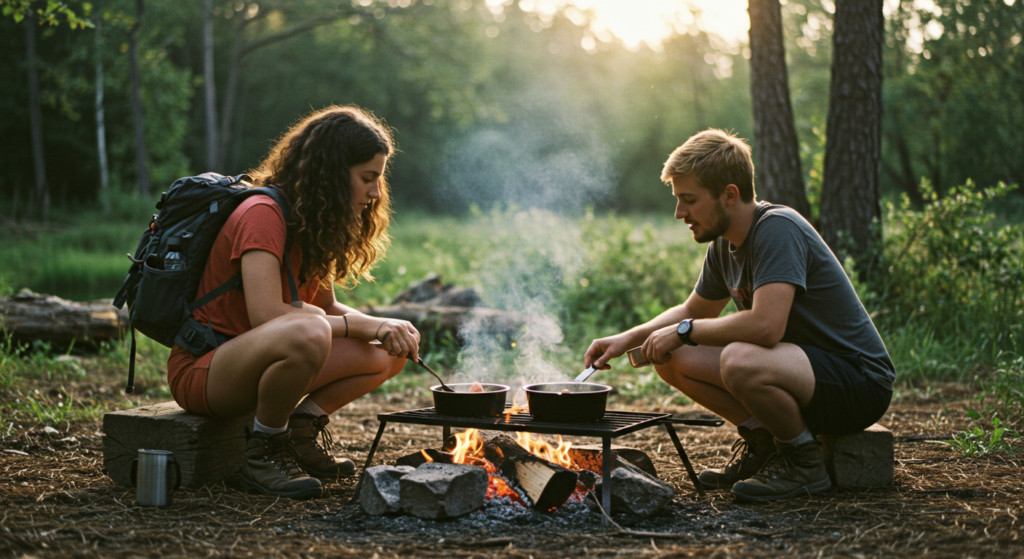
The call of the wild beckons, and for the adventurous soul, there’s a primal thrill in venturing beyond the manicured lawns and grocery aisles. But what if your trek takes an unexpected turn? Having the survival skill to create wilderness recipes in the wild isn’t just about having the knowledge; it’s about connecting with nature and appreciating its bounty.
Foraging as a survival skill has a rich history. For millennia, humans have relied on foraging – the act of collecting wild plants, nuts, and fruits – as a primary source of sustenance to create wilderness recipes. Archeological evidence suggests early humans munched on everything from dandelion greens to acorns, adapting their diets to the seasons and their surroundings.
Fast forward to today, foraging is experiencing a resurgence. It’s not just about survival; it’s about appreciating the diverse flavors and nutritional value that nature offers. Dandelions, once considered a pesky weed, are now celebrated for their bitter greens, rich in vitamins and antioxidants. Cattails, those ubiquitous marsh plants, boast edible shoots and starchy pollen heads that can be ground into flour.
But before you head out with a basket and an empty stomach, remember: knowledge is power. Not all plants and animals are created equal. Some can be downright poisonous, so proper identification is a crucial survival skill when creating wilderness recipes. Here are a few tips to get you started:
- Start with the Familiar: Begin by learning about common edible plants in your region. Consult reliable field guides and online resources, and never consume anything you’re unsure about.
- Seek Guidance: Consider joining a foraging workshop or guided nature walk led by a knowledgeable expert. They can teach you identification techniques, safe harvesting practices, and even basic recipes!
- Respect the Ecosystem: Take only what you need and leave the rest for others. Sustainable foraging ensures the continued availability of these wild resources.
- Now, let’s delve into a survival skill that might surprise you: turning a pinecone into a meal! Pine nuts, nestled within those prickly cones, have been a food source for thousands of years. Packed with protein and healthy fats, they were a staple for many indigenous cultures.
Using a Pinecone as Part of a Delicious Wilderness Recipe
Who knew a prickly pinecone could be hiding such a delicious secret? Nestled within those woody scales lies a treasure trove of nutty goodness – pine nuts! Foraging for pine nuts is a rewarding experience that connects you with nature’s bounty and adds a unique element to your wilderness recipes.
Here’s how to transform a pinecone into a tasty treat:
- Become a pinecone detective! Your target: mature cones that have shed their tight grip and opened naturally. These open cones are a telltale sign that the pine nuts inside are ripe and ready for harvest.
- There are a couple of ways to tackle this step. You can carefully pry open the cone with your fingers or a stick, releasing the pine nuts nestled within. If the cone is particularly stubborn, place it in a cloth bag and gently crush it with a rock or hammer. Remember, be gentle – you want the nuts, not crushed pinecone shrapnel!
- Once you’ve cracked the code (or cone), comes the rewarding part – extracting the bounty! Pick out the pine nuts, separating them from the shells and any debris. This might take some patience, but the reward is worth the effort.
- Now that you have your pine nut bounty, the culinary canvas awaits! Enjoy them raw for a slightly sweet and nutty taste. To unlock a deeper, richer flavor, try roasting them in a pan over low heat. Keep a watchful eye, as they can burn easily.
But pine nuts are more than just a snack. Grind them into a flour for a unique addition to your baking repertoire and other wilderness recipes. Add a sprinkle to salads and trail mixes for a delightful textural and taste bud explosion. Pine nuts can also be used to make pesto or incorporated into savory sauces, adding a depth of nutty complexity.
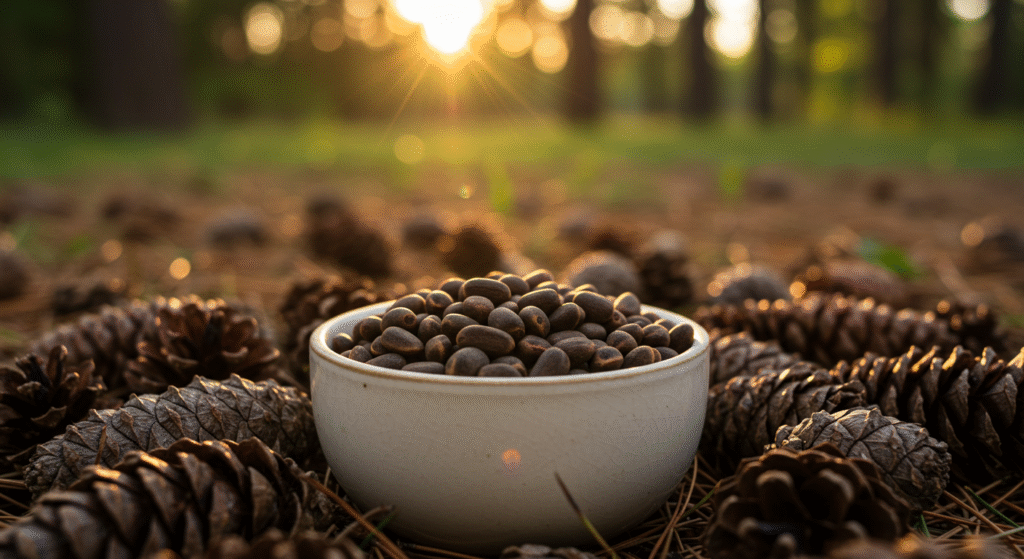
Rustic Recipes Using Food Found in Nature
Once you’ve mastered the art of foraging and pinecone plunder, it’s time to get creative in the wild kitchen! Here are three delicious ways to utilize nature’s edibles:
Dandelion Salad
Often overlooked as just a common weed, the dandelion is actually one of the most accessible and nutritious wild edibles you can find. Young dandelion greens have a bold, slightly bitter flavor similar to arugula or chicory, making them perfect for a fresh, trail-side salad.
For the best taste, harvest tender, young leaves in early spring or late fall when the bitterness is at its lowest. Simply rinse and toss them with other wild ingredients like wood sorrel, violets, or chickweed if available. Add a handful of nuts or seeds, a few slices of apple or radish, and dress it with a simple vinaigrette of olive oil, lemon juice, and a touch of honey.
You can even top your salad with edible dandelion blossoms for a pop of color and a subtle honey-like sweetness. It’s a simple, refreshing way to enjoy wild foraged food and a great source of vitamins A, C, and K.
Dandelion salad is perfect as a light camp lunch or a vibrant side dish that connects your meal directly to the landscape around you.
Ingredients:
- 2 cups of fresh dandelion greens
- 1/4 cup of chopped walnuts
- 1/4 cup of crumbled feta cheese
- 2 tablespoons of olive oil
- 1 tablespoon of apple cider vinegar
- 1 teaspoon of honey
- Salt and pepper to taste
Directions:
- Rinse and chop the dandelion greens.
- In a separate bowl, whisk together the olive oil, apple cider vinegar, honey, salt, and pepper.
- Toss the dandelion greens with the dressing.
- Sprinkle walnuts and feta cheese on top.
- Enjoy!
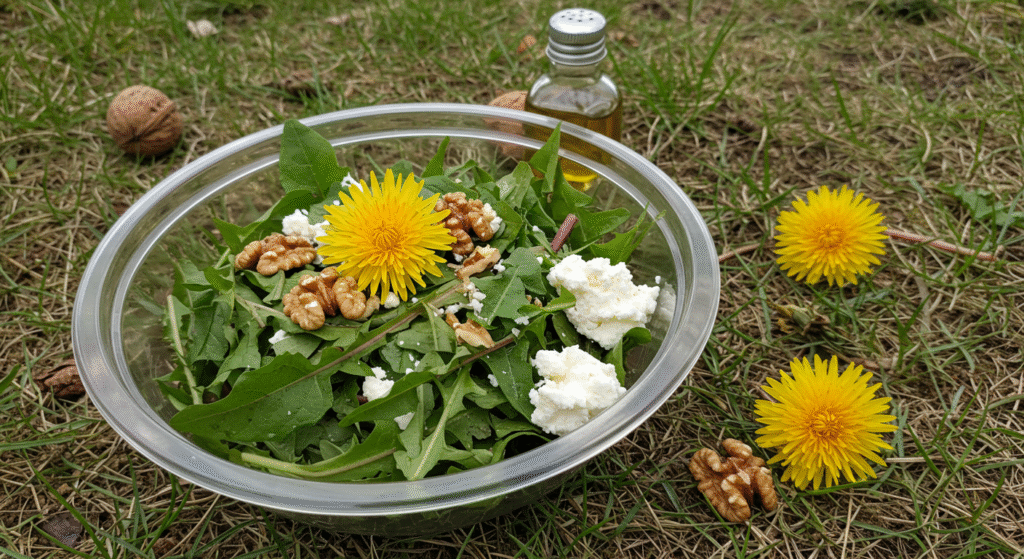
Squirrel Stew
Squirrel stew is a rustic classic that has nourished hunters, homesteaders, and outdoor adventurers for generations. Lean, gamey, and surprisingly tender when slow-cooked, squirrel meat makes an excellent base for a hearty stew that’s perfect after a day of tracking or hiking.
Start by browning the cleaned squirrel pieces in a bit of oil or fat to lock in flavor. Then simmer them slowly with chopped onions, carrots, potatoes, and wild herbs like thyme, juniper, or even spruce tips if available. A splash of broth or water helps create a rich, savory base that pulls all the flavors together.
Squirrel is best cooked low and slow, either over a campfire or in a Dutch oven, to break down the connective tissue and make the meat fall-off-the-bone tender. Add a touch of vinegar or wine to brighten the dish, and season generously with salt, pepper, and any foraged greens or mushrooms you’ve gathered.
Whether you’re cooking over an open flame or simmering at base camp, squirrel stew is a protein-packed, soul-warming meal that connects you to the land and the heritage of wild cooking.
Ingredients:
- 2 squirrels, cleaned and quartered
- 1 carrot chopped
- 1 onion, chopped
- 2 cloves of garlic, minced
- 2 cups of chicken broth
- 1 cup of wild mushrooms, sliced
- 1 tablespoon of olive oil
- Salt and pepper to taste
Directions:
- Heat olive oil in a large pot over medium heat.
- Add the onion and garlic and sautè until translucent.
- Add the squirrel and cook until browned.
- Pour in the chicken broth and bring to a boil.
- Reduce heat and simmer for 30 minutes.
- Add the carrots and wild mushrooms and continue to simmer for an additional 15 minutes.
- Season with salt and pepper to taste.
- Serve hot and enjoy!
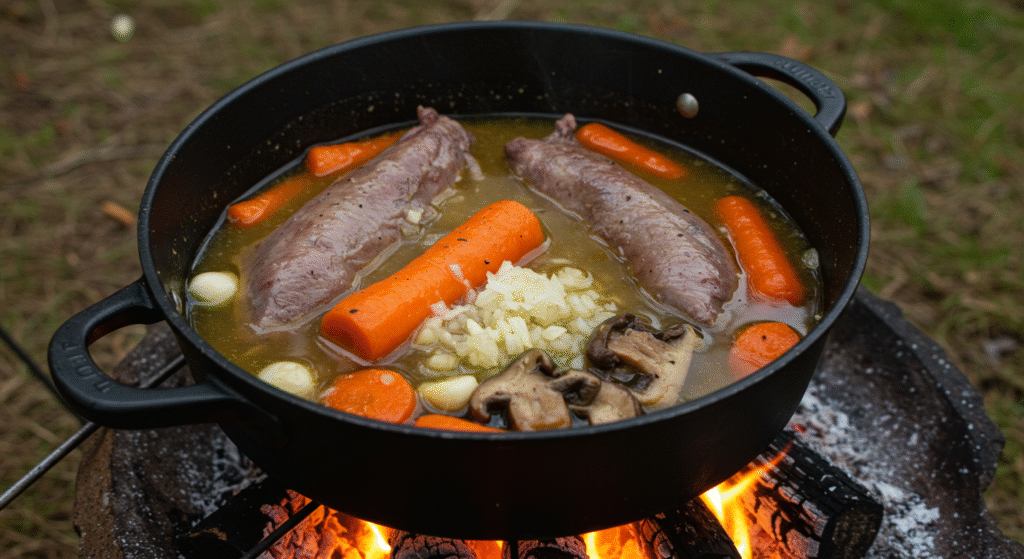
Berry Cobbler
Berry cobbler is the ultimate rustic dessert, especially when made with wild berries picked fresh from the trail. Whether you’ve gathered blueberries, blackberries, raspberries, or huckleberries, this classic treat captures the natural sweetness of summer in every bite.
To make it, start by layering your fresh berries with a sprinkle of sugar and a touch of lemon juice in a cast iron skillet or camp-safe baking dish. Then mix up a simple topping using flour, baking powder, butter, and a bit of milk or water. Drop the batter over the berries and let the whole thing bake over hot coals or in a Dutch oven until golden brown and bubbling.
The result is a warm, gooey, fruit-filled dessert with a crisp, biscuit-like crust—easy to make outdoors and always a crowd-pleaser around the campfire. Top it with a dollop of whipped cream (if you packed it) or enjoy it straight from the skillet for a truly wild reward.
Berry cobbler is a perfect way to end a day of hiking, fishing, or foraging, and a sweet reminder of the flavors the wilderness has to offer.
Ingredients:
- 2 cups of mixed wild berries
- 1/2 cup of flour
- 1/2 cup of oats
- 1/2 cup of brown sugar
- 1/2 cup of butter, melted
- 1/2 teaspoon of cinnamon
- Vanilla ice cream (optional)
Directions:
- Preheat oven to 375°F.
- Rinse and pat dry the mixed wild berries.
- In a mixing bowl, combine the flour, oats, brown sugar, melted butter, and cinnamon to create a crumble topping.
- Spread the mixed wild berries evenly in a baking dish.
- Sprinkle the crumble mixture over the berries.
- Bake for 30 minutes or until the topping is golden brown and the berries are bubbly.
- Serve hot with a scoop of vanilla ice cream (optional).
- Enjoy!
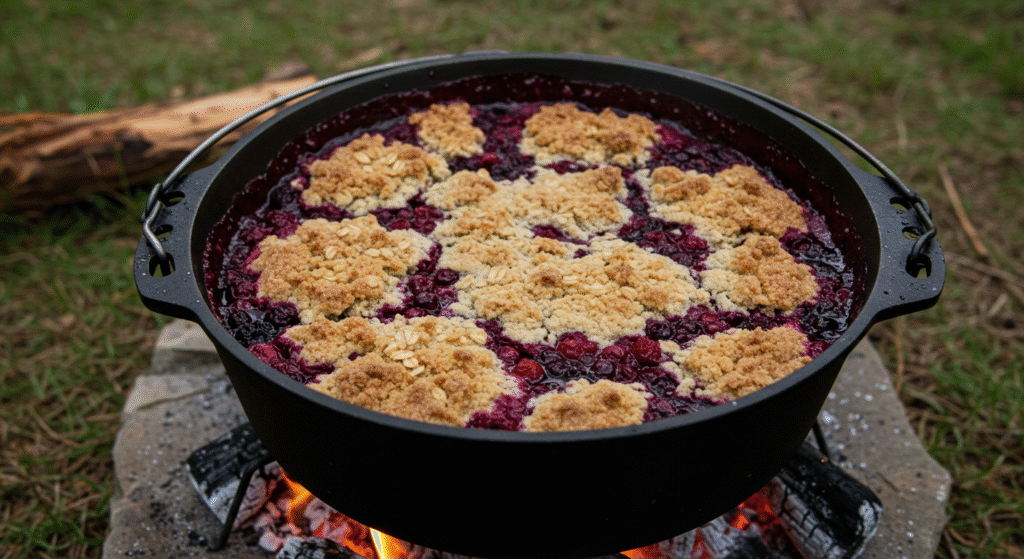
Here are three additional wilderness recipes that showcase the culinary potential of nature’s bounty:
- Stinging Nettle Soup (with a Twist)
Stinging nettles may have been the plant you carefully avoided on childhood hikes, but once you know how to handle them, they become a surprisingly delicious and nutrient-packed ingredient. This earthy green soup is rich in iron, calcium, magnesium, and vitamin C, making it a perfect way to refuel after a long day on the trail.
The key is simple: wear gloves while harvesting and blanch the leaves to remove their sting. Once cooked, the nettles take on a flavor similar to spinach, with a slightly nutty, herbal twist. Add potatoes, garlic, onions, and a swirl of cream or coconut milk, and you’ve got a comforting, flavorful bowl that blends rustic tradition with modern nutrition.
The twist? A hint of lemon zest and smoked paprika to elevate the flavor and balance the wild greens with a touch of warmth and brightness.
- Cattail Fritters
Cattails are more than just eye-catching reeds swaying in the wetlands, they’re a wild edible powerhouse. In fact, nearly every part of the cattail is usable, but the tender young shoots (often called “cossack asparagus”) and the bright yellow pollen heads are especially tasty when transformed into fritters.
To make these wild fritters, harvest the young shoots in spring or collect pollen in early summer. Peel the shoots to reveal the tender inner core, or sift the pollen into flour. Dip either into a simple batter made with flour, egg, and water, then fry them in hot oil until they turn golden and crisp.
The result is a flavorful, slightly nutty fritter with a satisfying crunch, perfect as a trail snack, campfire side dish, or even an unexpected appetizer. Add a pinch of salt, a squeeze of lemon, or a spicy dipping sauce for an extra layer of flavor.
These foraged treats are easy to make, packed with nutrients, and a fun way to connect with the land on your next outdoor adventure.
- Wild Berry Buckwheat Pancakes
Pancakes get a delicious wilderness upgrade with this rustic backcountry recipe. Instead of traditional flour, these pancakes use buckwheat flour; a naturally gluten-free, nutrient-dense alternative packed with fiber, protein, and antioxidants. The rich, earthy flavor of buckwheat pairs perfectly with the sweet and tart burst of foraged wild berries like blueberries, huckleberries, or black raspberries.
Whip up the batter at camp or before your trip with simple ingredients like buckwheat flour, eggs, water or milk, a touch of baking powder, and a pinch of salt. Cook them over a campfire griddle or portable stove until they’re fluffy and golden.
Top with a handful of freshly picked berries and a drizzle of maple syrup or honey for a naturally sweet finish. It’s a satisfying breakfast that fuels your adventure and celebrates the flavors of the wild. No boxed mix required.
Perfect for early mornings at basecamp, this pancake wilderness recipe is are a comforting and energizing way to start your day in the outdoors.
The Art of Turning Wilderness into a Culinary Canvas
The next time you venture into the wild, whether it’s a shady forest trail, an open meadow, or a quiet lakeside, you might be walking through a pantry full of edible treasures. With a bit of knowledge, basic outdoor cooking skills, and a spirit of curiosity, you can turn your surroundings into an ever-changing kitchen filled with wilderness recipes you won’t find in a typical cookbook.
Foraging is more than a survival skill. It is a way to connect deeply with the land, appreciate the richness of local ecosystems, and add fresh, seasonal ingredients to your meals. From nettle soups and cattail fritters to buckwheat pancakes topped with wild berries, nature offers a bounty of wholesome, wilderness recipes that elevate your outdoor experiences.
Just remember:
- Learn to identify wild edibles properly
- Harvest sustainably and respectfully
- Follow local foraging laws and guidelines
- Leave no trace and protect native habitats
With all of the wilderness recipes you create or follow, you are not just feeding your body. You are enriching your journey with stories, flavors, and a stronger bond to the natural world.
Happy feasting, and may your campfire always be warm and your plate wild.
